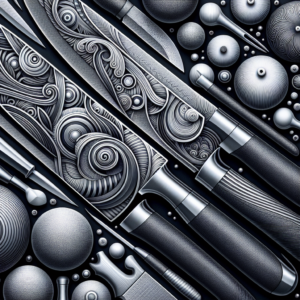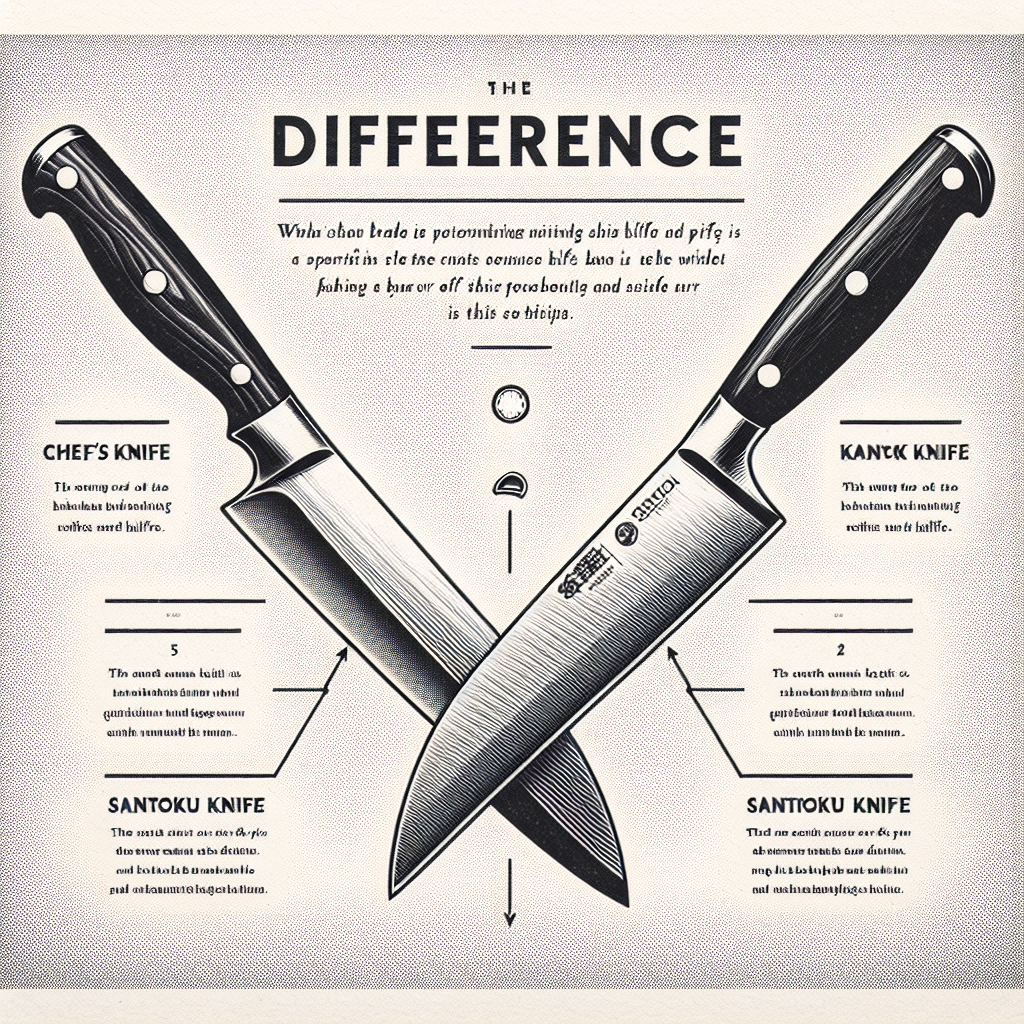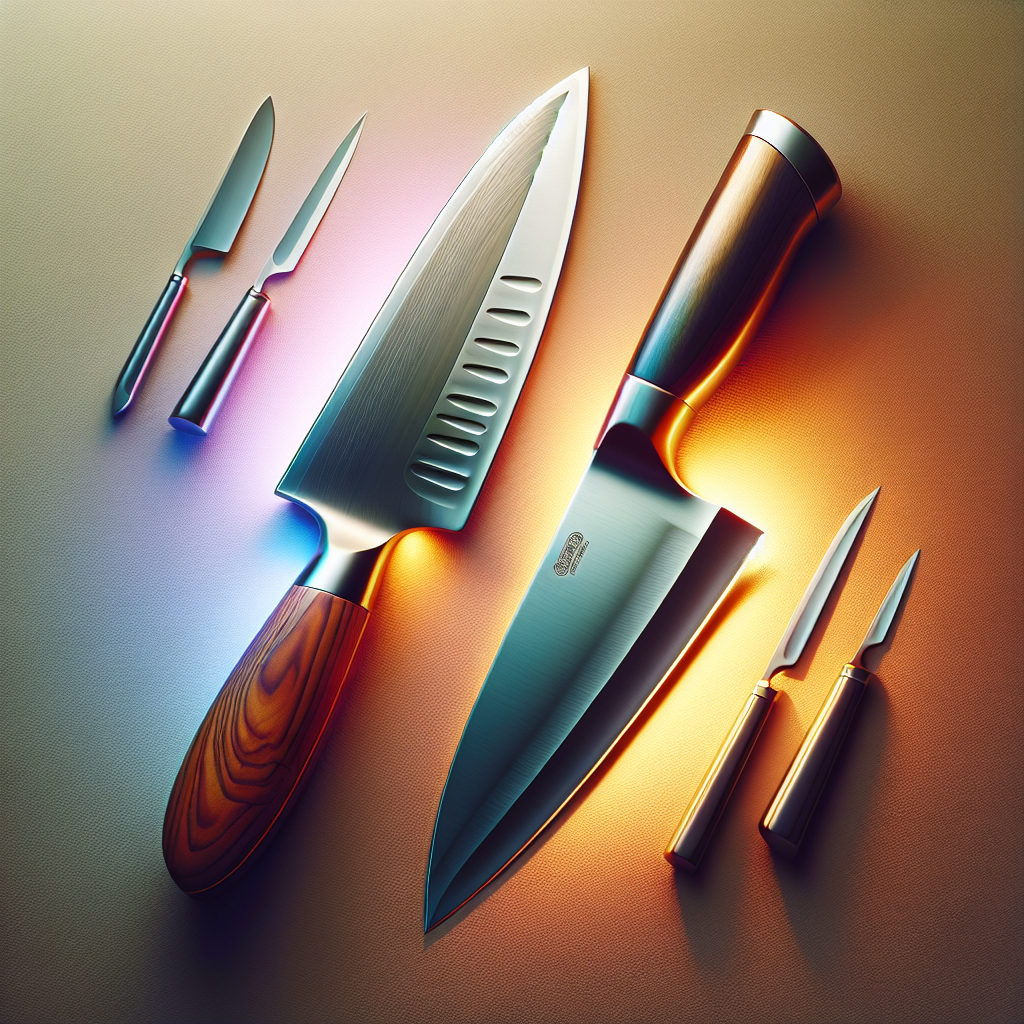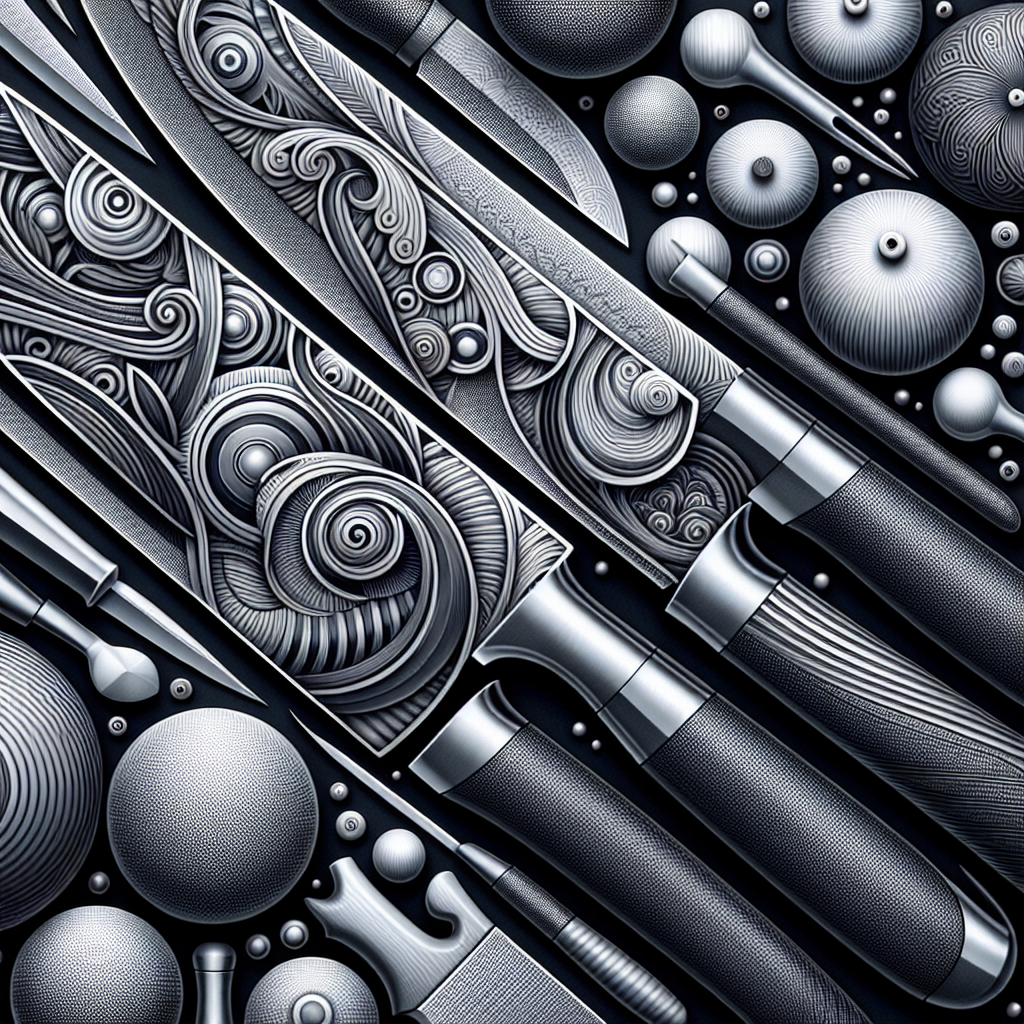What’s The Difference Between A Chef’s Knife And A Santoku Knife?
November 20, 2023

If you’re someone who enjoys spending time in the kitchen, you’ve likely come across the terms “chef’s knife” and “Santoku knife.” But have you ever wondered what sets these two popular knives apart? While they both serve as versatile tools for slicing, dicing, and chopping, there are some key differences that make each knife unique. In this article, we’ll explore the distinct qualities of a chef’s knife and a Santoku knife, helping you understand which one is best suited for your culinary adventures. So, grab your cutting board and let’s embark on this journey to unravel the mystery behind these essential kitchen companions.

Blade Shape
Chef’s Knife Blade Shape
The blade shape of a chef’s knife is characterized by a slight curve, which allows for a rocking motion while chopping, slicing, and dicing. This curved blade shape is ideal for tasks that require a continuous motion, making it versatile for various cutting techniques. The curved edge, combined with a pointed tip, also provides excellent precision and control when working with intricate cuts, such as mincing herbs or creating decorative designs on vegetables.
Santoku Knife Blade Shape
On the other hand, a Santoku knife features a straighter blade shape with little to no curve. This shape is often compared to a smaller and lighter version of a cleaver. The lack of curve in the Santoku blade is intentional, as it allows for a more precise downward motion when cutting, resulting in clean and even slices. The tip of a Santoku knife is less pointed compared to a chef’s knife, making it safer to work with and reducing the risk of accidental injuries.
Blade Length
Chef’s Knife Blade Length
Chef’s knives typically come in a range of blade lengths, but the most common lengths range from 8 to 12 inches. The longer blade length offers a larger cutting surface, making it easier to handle larger ingredients and perform long slicing motions effortlessly. Moreover, a longer blade allows for better leverage, which is particularly beneficial when working with tougher or denser foods.
Santoku Knife Blade Length
Santoku knives usually have a shorter blade length compared to chef’s knives, typically ranging from 5 to 7 inches. The shorter length provides more control and maneuverability, making it ideal for precision tasks and working in tight spaces. While it may not be as efficient for slicing large ingredients, the Santoku knife excels in tasks that require finesse and delicate handling.

Blade Thickness
Chef’s Knife Blade Thickness
The blade thickness of a chef’s knife varies depending on its purpose and design. Generally, chef’s knives tend to have a thicker spine near the bolster and gradually thin towards the edge. This design allows for a sturdy and durable knife that can handle heavy-duty tasks without compromising flexibility. A thicker blade is also less prone to chipping or breaking, providing longevity to the knife.
Santoku Knife Blade Thickness
Santoku knives typically have a thinner blade compared to chef’s knives. The thinner blade allows for precise and clean cuts, particularly when working with delicate foods like fish or vegetables. The reduced thickness also contributes to the overall lighter weight of the knife, making it easier to maneuver and control during intricate slicing techniques.
Blade Edge
Chef’s Knife Blade Edge
Traditionally, chef’s knives feature a double-beveled blade edge, meaning both sides of the blade are angled to form the cutting edge. This symmetrical design provides versatility, allowing for both right-handed and left-handed individuals to use the knife comfortably. The double bevel also facilitates smooth and clean cuts on a wide range of ingredients.
Santoku Knife Blade Edge
Santoku knives also have a double-beveled blade edge, ensuring versatility and ease of use for both right-handed and left-handed individuals. However, there is a slight difference in the edge design. Santoku knives often have a flatter edge compared to chef’s knives, allowing for a more efficient push-and-pull slicing motion. This flat edge design enhances the knife’s ability to create thin slices with minimal effort.

Purpose
Chef’s Knife Purpose
A chef’s knife is considered the workhorse of the kitchen due to its multifunctionality. It is designed to handle a wide range of tasks, including chopping, mincing, slicing, and dicing. Whether you are preparing vegetables, meat, or fish, a chef’s knife will be your go-to tool. Its versatility makes it an essential tool for both professional chefs and home cooks.
Santoku Knife Purpose
The Santoku knife, originating from Japan, has a more specific purpose. The word “Santoku” means “three virtues” or “three uses” in Japanese, referring to its ability to handle three main tasks: slicing, dicing, and mincing. This knife is perfect for precision cuts, especially when working with smaller ingredients such as herbs or delicate proteins like sushi-grade fish. Its versatility and maneuverability make it a popular choice for Japanese cuisine.
Primary Cutting Techniques
Chef’s Knife Cutting Techniques
The chef’s knife excels at various cutting techniques, allowing you to tackle any ingredient with confidence. The primary cutting techniques performed with a chef’s knife include:
- Chopping: The chef’s knife’s curved blade and comfortable grip make it ideal for swiftly chopping vegetables, herbs, or boneless meats into smaller pieces.
- Slicing: With its long and sharp blade, the chef’s knife effortlessly slices through larger ingredients, such as roasts or melons, creating precise and even slices.
- Dicing: By using a rocking motion combined with the knife’s sharp edge, the chef’s knife can easily dice onions, potatoes, or other vegetables into uniform pieces.
- Mincing: The pointed tip and fine edge of the chef’s knife make it perfect for finely mincing garlic, shallots, or fresh herbs, releasing their flavors and aromas.
Santoku Knife Cutting Techniques
The Santoku knife’s design lends itself to specific cutting techniques:
- Slicing: Due to its shorter blade length, the Santoku knife allows for controlled and precise slicing. Whether it’s thinly slicing ingredients for sushi or creating paper-thin cuts of vegetables, the Santoku knife excels in creating clean and consistent slices.
- Dicing: The Santoku knife’s flatter edge and precise blade make it effective for dicing smaller ingredients, such as onions, garlic, or fruits, into neat and uniform pieces.
- Mincing: With its fine edge and nimble size, the Santoku knife is perfect for finely mincing delicate herbs and aromatics, enabling you to achieve a consistently fine texture.
Food Types
Chef’s Knife Food Types
The chef’s knife is versatile enough to handle a wide variety of food types, including:
- Vegetables: From leafy greens to root vegetables, the chef’s knife’s curved blade and rocking motion allow for efficient and precise cutting of various vegetables.
- Meats: Whether it’s deboning a chicken, trimming a steak, or carving a roast, the chef’s knife’s sharp and sturdy blade makes it a reliable tool for working with different types of meat.
- Fish: With its fine edge and pointed tip, the chef’s knife can delicately portion fish or remove the skin without damaging the flesh.
- Fruits: From melons to citrus fruits, the chef’s knife’s long and sharp blade effortlessly cuts through the skins and slices fruits with ease.
Santoku Knife Food Types
While the Santoku knife may not be as versatile as a chef’s knife, it excels in handling certain food types:
- Small Vegetables: When it comes to precision cuts on small vegetables like cherry tomatoes, mushrooms, or shallots, the Santoku knife’s smaller size and precise cutting edge make it the right tool.
- Boneless Meats: As long as you’re not dealing with bones, the Santoku knife can handle boneless meats with ease. It’s perfect for thinly slicing chicken breasts or pork tenderloins.
- Fish and Seafood: The Santoku knife’s fine edge is perfect for slicing delicate fish fillets, shucking oysters, or removing the skin from fish without causing any damage to the flesh.
Weight and Balance
Chef’s Knife Weight and Balance
Chef’s knives are generally heavier compared to Santoku knives, as they are designed to handle more demanding tasks. The weightier blade provides better momentum and power behind each cut, making it easier to work with denser ingredients or when applying more force is necessary. Additionally, a well-balanced chef’s knife ensures comfortable handling and minimizes hand fatigue, allowing for extended periods of use without discomfort.
Santoku Knife Weight and Balance
Santoku knives tend to be lighter in weight compared to chef’s knives, making them nimble and easy to maneuver. The lighter weight allows for precise control and reduces strain on the wrist during repetitive slicing or dicing tasks. The balance of a Santoku knife is typically shifted towards the blade, providing a sense of control and stability for delicate cutting techniques.
Handle Design
Chef’s Knife Handle Design
The handle of a chef’s knife varies in design, but most commonly, it is made of materials like wood, synthetic composites, or stainless steel. The handle is typically ergonomic, shaped to provide a comfortable and secure grip. It allows for maximum control over the knife, ensuring safety and reducing the risk of accidents. The handle design may also include a bolster, which is a thick metal section between the blade and handle, providing balance and stability.
Santoku Knife Handle Design
Santoku knives often feature a handle made of wood or synthetic materials. The handle’s design aims for a comfortable grip, allowing for precise control over the knife’s movements. Some Santoku knives may incorporate a full tang, where the blade extends through the handle, providing additional strength and balance. The handle design is often ergonomic, catering to various hand sizes and reducing fatigue during prolonged use.
Price
Chef’s Knife Price
Chef’s knives come in a wide range of price points, depending on the materials used, craftsmanship, and brand reputation. Entry-level chef’s knives can be found for as low as $30, while high-end professional-grade knives can cost several hundred dollars. It is important to consider the quality and durability of the knife, as a well-crafted chef’s knife can last a lifetime with proper care and maintenance.
Santoku Knife Price
Santoku knives also vary in price, depending on the quality and brand. Entry-level Santoku knives can be found for around $20, while higher-end models can reach up to $200 or more. It is essential to strike a balance between quality and budget when choosing a Santoku knife, as a higher price may indicate superior craftsmanship and longevity. However, there are affordable options available that still provide excellent performance for everyday use.
In conclusion, while both the chef’s knife and Santoku knife are invaluable tools in the kitchen, they do have distinct differences in blade shape, length, thickness, edge design, and purpose. The chef’s knife, with its curved blade and versatility, is excellent for a wide range of cutting techniques and food types. On the other hand, the Santoku knife’s straighter blade, shorter length, and precise edge make it ideal for precision cuts and delicate tasks. Ultimately, the choice between the two will depend on your specific cooking style, preferences, and the types of foods you commonly prepare.
